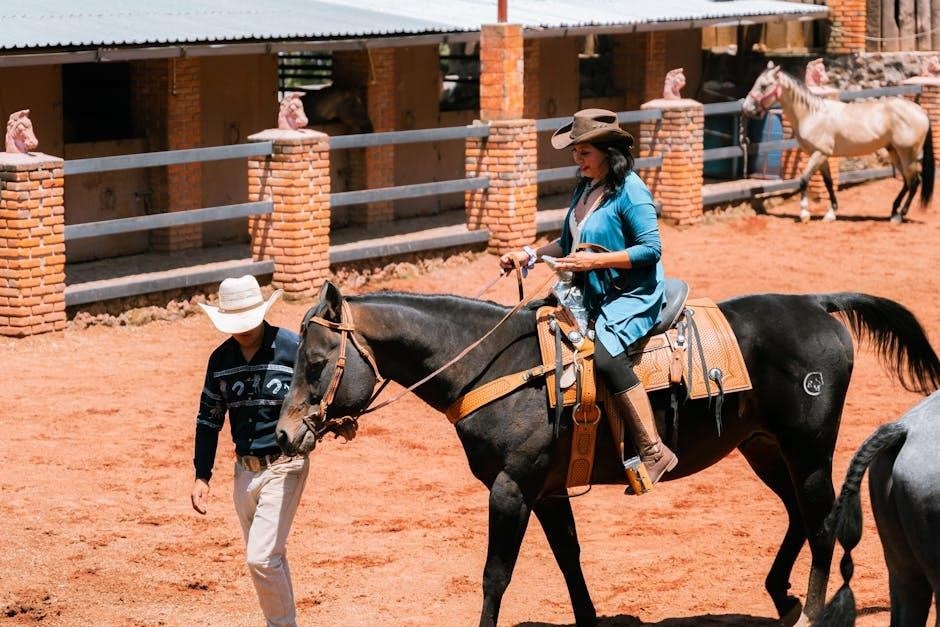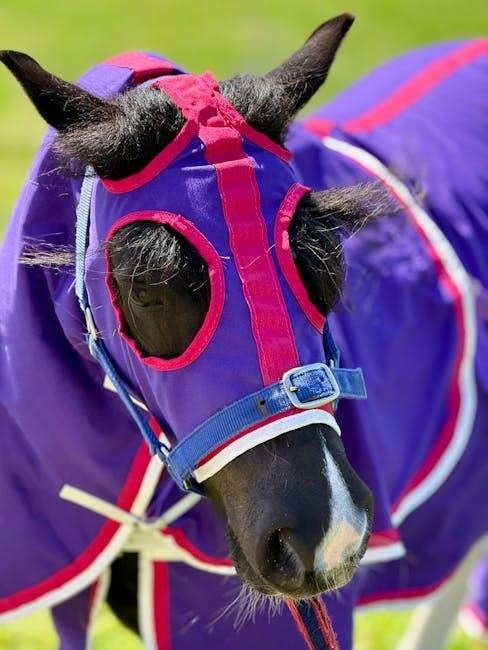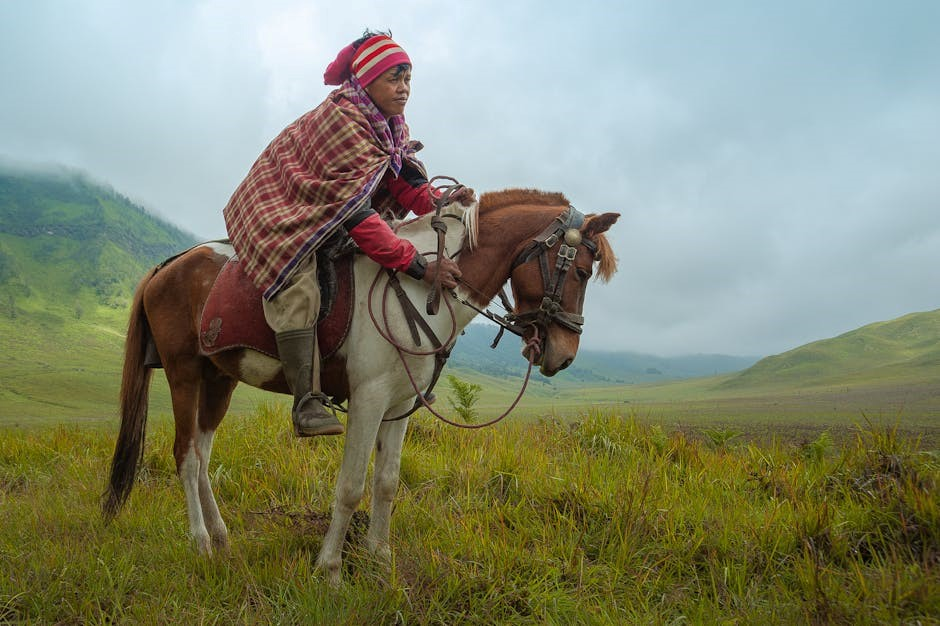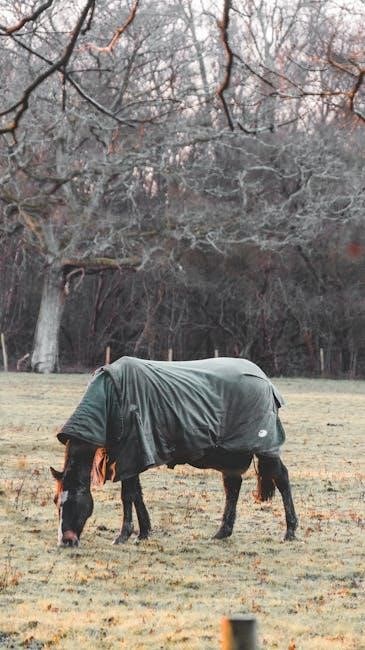Proper horse blanketing is essential for maintaining comfort and health during colder months. This guide provides clarity on when to blanket‚ considering temperature and individual needs.
Understanding the Importance of Blanketing Horses
Blanketing horses is crucial for protecting them from cold temperatures and wind‚ which can lead to discomfort and health issues. Horses naturally grow a winter coat to insulate themselves‚ but extreme weather conditions may require additional support. Blankets help prevent heat loss‚ ensuring the horse maintains energy reserves. Without proper blanketing‚ horses may struggle in harsh weather‚ leading to hypothermia or exhaustion. Conversely‚ over-blanketing can cause overheating‚ especially in milder temperatures. Understanding when and how to blanket is essential for balancing comfort and health‚ ensuring the horse remains comfortable and thrives throughout the winter months.
Objective of the Temperature Guide
The primary objective of this temperature guide is to provide horse owners with clear‚ evidence-based recommendations for blanketing their horses effectively. By outlining specific temperature ranges and corresponding blanket requirements‚ the guide aims to simplify decision-making. It addresses factors such as a horse’s natural coat‚ environmental conditions‚ and individual needs‚ ensuring optimal comfort and health. The guide also emphasizes the importance of monitoring weather changes and adjusting blankets accordingly. Ultimately‚ its goal is to empower owners to make informed choices‚ preventing both under-blanketing and over-blanketing scenarios. This comprehensive approach ensures horses are protected without compromising their well-being.

Key Considerations for Blanketing Horses
Blanketing horses requires careful assessment of their coat type‚ climate adaptation‚ age‚ health‚ and living conditions to ensure their comfort and prevent overheating or chilling.
Horse’s Natural Coat and Climate Adaptation
A horse’s natural coat adapts to seasonal changes‚ thickening in winter for insulation. Horses in colder climates develop denser coats‚ while those in milder areas may have lighter ones. Clipped horses lose this natural insulation‚ necessitating blankets earlier in the season. Climate adaptation also plays a role; horses acclimated to colder temperatures may need less blanketing than those in warmer regions. Understanding your horse’s coat type and climate acclimation is crucial for determining blanket needs. Over blanketing can lead to sweating and discomfort‚ while under blanketing may cause chilling. Always consider these factors when deciding on the appropriate blanket for your horse.

Factors Affecting a Horse’s Need for Blanketing
Several factors influence a horse’s need for blanketing‚ including age‚ health‚ and body condition. Senior horses or those with medical conditions may require additional warmth. Horses with a full winter coat generally need less blanketing‚ while clipped horses often require more. Humidity‚ wind‚ and shelter availability also play significant roles. A horse’s activity level and access to forage further impact their ability to stay warm. For example‚ a horse with ample forage generates internal heat‚ reducing the need for heavy blanketing. Each horse’s unique circumstances must be considered to ensure their comfort and prevent overheating or chilling. Regular assessment is key to meeting their specific needs effectively.
Role of Shelter and Wind Protection
Shelter and wind protection are crucial in determining a horse’s blanketing needs. Adequate shelter can significantly reduce wind chill‚ which often makes temperatures feel colder. Horses in open pastures without shelter may require heavier blanketing compared to those with access to a barn or three-sided shed. Wind protection helps prevent heat loss‚ allowing the horse’s coat to insulate effectively. Even with appropriate blanketing‚ harsh winds can still cause discomfort. Ensuring access to reliable shelter minimizes the risk of hypothermia and reduces reliance on heavy blankets. Always consider the availability and quality of shelter when deciding the appropriate weight and type of blanket for your horse.

Temperature Guidelines for Blanketing
Blanket based on temperature: above 50°F‚ no blanket needed; 40-50°F‚ lightweight; 30-40°F‚ medium-weight; below 30°F‚ heavy or layered blankets for optimal comfort and protection.
Above 50°F: No Blanket Needed for Most Horses
When temperatures exceed 50°F‚ most horses do not require blanketing. Their natural coats and body heat are sufficient to maintain comfort. Over-blanketing can lead to overheating‚ discomfort‚ and potential health issues. Horses with full winter coats are particularly at risk of overheating in warmer conditions. However‚ clipped horses or those with lighter coats may still need lightweight protection if winds are strong or temperatures drop significantly at night. Always monitor your horse’s behavior and physical condition to ensure their well-being. Removing blankets during warmer days helps prevent unnecessary stress and ensures optimal comfort for your horse.
40°F to 50°F: Lightweight Blanket or Sheet
When temperatures range from 40°F to 50°F‚ most horses benefit from a lightweight blanket or sheet to stay comfortable. This range is ideal for providing protection without causing overheating. For unclipped horses with a natural winter coat‚ a sheet may suffice‚ while clipped horses or those with thinner coats may require a lightweight blanket. It’s important to consider wind chill and moisture‚ as these factors can make the environment feel cooler. Monitoring your horse’s comfort and adjusting the blanket as needed ensures their well-being. Avoid using heavy blankets in this range‚ as they can lead to discomfort and sweating. Lightweight options are designed to protect without restricting movement or causing heat buildup.
30°F to 40°F: Medium-Weight Blanket
When temperatures drop to the range of 30°F to 40°F‚ a medium-weight blanket is typically recommended for most horses. This weight provides adequate insulation without overwhelming the horse‚ ensuring comfort in cooler conditions. For clipped horses or those with a thinner coat‚ a medium-weight blanket is especially important to prevent chilling. Unclipped horses with a full winter coat may still benefit from a lighter option‚ depending on their individual needs and environment. It’s crucial to consider wind chill and moisture‚ as these can make the temperature feel cooler. Proper fit and comfort are essential to avoid chafing or restricted movement. Regular monitoring ensures the horse remains comfortable and protected during this range.
Below 30°F: Heavy Blanket or Layering
When temperatures drop below 30°F‚ a heavy blanket or layering of blankets is necessary to protect horses from extreme cold. This range requires maximum insulation to maintain body heat‚ especially for clipped horses‚ which may struggle to stay warm. Unclipped horses with a full winter coat might still need a medium-weight blanket‚ depending on their individual tolerance and environmental conditions. Wind chill and moisture can exacerbate the cold‚ making it feel even colder‚ so proper protection is crucial. Layering allows for adjustability‚ ensuring the horse remains comfortable without overheating. Regular monitoring and adjustments are essential to prevent chilling or discomfort in such harsh weather conditions.

Special Considerations
Special considerations for blanketing include a horse’s coat type‚ climate adaptation‚ age‚ health‚ and extreme weather conditions like wind chill and moisture‚ which affect comfort and needs.
Blanketing Clipped Horses
Clipped horses require special attention when blanketing‚ as their natural coat has been reduced‚ making them more sensitive to cold. A clipped horse typically needs blanketing at higher temperatures compared to unclipped horses. For example‚ a clipped horse may need a lightweight blanket when the temperature drops below 60°F and a heavier blanket as temperatures fall further. It’s important to monitor their comfort and adjust the blanket weight accordingly. Additionally‚ clipped horses may need layering options to provide flexibility in changing conditions. Always ensure the blanket fits properly to prevent discomfort or restriction. Regular checks are essential to avoid overheating‚ especially in milder winter days.

Blanketing Horses with a Full Winter Coat
Horses with a full winter coat generally have natural insulation‚ reducing the need for heavy blanketing. However‚ their needs vary based on temperature and conditions. A horse with a full coat may only require a lightweight blanket in temperatures between 40°F to 50°F. Below 40°F‚ a medium-weight blanket might be necessary‚ depending on wind and moisture. Heavy blanketing is usually reserved for extreme cold‚ below 30°F‚ to prevent chilling. It’s crucial to avoid over-blanketing‚ as this can cause overheating and discomfort. Always consider the horse’s individual tolerance and external factors like wind chill and humidity when deciding the appropriate blanket weight.
Wind Chill and Moisture Factors
Wind chill and moisture significantly impact a horse’s need for blanketing. Wind chill can make the air feel colder than the actual temperature‚ increasing heat loss. Horses in windy conditions may require an additional layer of protection‚ even if the temperature hasn’t dropped drastically. Moisture‚ such as rain or snow‚ exacerbates heat loss‚ as a wet coat loses insulating properties. In such cases‚ a waterproof blanket is essential to keep the horse dry and warm. Always consider these factors when deciding the weight and type of blanket‚ ensuring the horse remains comfortable without risking overheating. Proper adjustments based on weather conditions are critical for optimal care.

Best Practices for Managing Blankets
Monitor weather daily‚ adjust blankets as temperatures change‚ ensure proper fit‚ and inspect blankets frequently to prevent discomfort or injury‚ optimizing your horse’s comfort and safety.

Regular Monitoring of Weather Conditions
Regularly monitoring weather conditions is crucial for determining your horse’s blanketing needs. Check daily temperature forecasts‚ wind chill‚ and moisture levels‚ as these factors significantly impact your horse’s comfort. Temperature fluctuations can quickly change the necessity for a blanket‚ especially in climates with unpredictable weather patterns. Wind chill can make temperatures feel much colder‚ while moisture‚ such as rain or snow‚ can reduce a blanket’s insulating properties. By staying informed about weather changes‚ you can adjust your horse’s blanket accordingly‚ ensuring they remain comfortable and protected without risking overheating or chilling. This proactive approach helps maintain your horse’s well-being throughout the colder months.
Adjusting Blankets According to Temperature Changes
Adjusting your horse’s blankets based on temperature changes is vital to ensure their comfort and prevent overheating or chilling. Monitor temperature fluctuations closely and switch blankets accordingly. For example‚ use a lightweight blanket in milder temperatures (40°F–50°F) and transition to a medium-weight blanket as temperatures drop (30°F–40°F). In extreme cold (below 30°F)‚ opt for a heavy blanket or layering for added warmth. Always consider your horse’s individual needs‚ such as whether they have a full winter coat or have been clipped. Regular adjustments help maintain your horse’s comfort and prevent potential health issues related to over- or under-blanketing.
Ensuring Proper Fit and Comfort
Ensuring your horse’s blanket fits properly is crucial for their comfort and safety. A poorly fitted blanket can cause chafing‚ restrict movement‚ or even lead to injury. Always check that the blanket lies flat along the horse’s back‚ with the neck opening and girth straps adjusted to prevent shifting. Avoid blankets that are too tight‚ as they can impede breathing and movement‚ or too loose‚ as they may rub or get caught on objects. Regularly inspect the blanket for signs of wear or damage‚ and make adjustments as needed. Proper fit ensures your horse stays comfortable‚ conserves energy‚ and remains healthy throughout the winter season.
daily Inspection and Adjustment of Blankets
Daily Inspection and Adjustment of Blankets
Daily inspection of your horse’s blanket is crucial to ensure comfort and safety. Check for proper fit‚ as shifts or tightness can cause discomfort or injury. Adjust straps and buckles to maintain a snug yet comfortable fit‚ avoiding pressure points. Inspect for signs of wear‚ such as tears or frayed edges‚ and clean the blanket regularly to prevent dirt buildup. Monitor your horse’s behavior for signs of distress‚ like excessive sweating or restlessness‚ which may indicate overheating. Adjust the blanket weight or remove it if temperatures rise unexpectedly. Regular checks ensure your horse remains comfortable and healthy‚ preventing potential issues before they escalate.

Common Mistakes to Avoid
Avoid over-blanketing in mild weather‚ which can cause overheating‚ and under-blanketing in extreme cold‚ risking hypothermia. Always consider individual horse needs and climate conditions carefully.

Over-Blanketing in Mild Weather
Over-blanketing in mild weather is a common mistake that can cause discomfort and stress for horses. When temperatures are above 50°F‚ most horses‚ especially those with natural coats‚ do not need blanketing. Using heavy or unnecessary blankets in such conditions can lead to overheating‚ sweating‚ and skin irritation. This can also suppress the horse’s natural ability to regulate its body temperature. It’s important to monitor weather forecasts and remove or replace blankets with lighter options when temperatures rise. Always prioritize your horse’s comfort and adjust blanketing accordingly to prevent health issues related to over-blanketing.
Under-Blanketing in Extreme Cold
Under-blanketing in extreme cold can lead to serious health issues for horses‚ including hypothermia and discomfort. When temperatures drop below 30°F‚ horses need adequate protection to maintain their body heat. Failure to provide a heavy blanket or layering can leave them vulnerable‚ especially if they have a clipped coat or lack access to shelter. Horses in such conditions may struggle to stay warm‚ leading to stress and potential illness. It’s crucial to assess the severity of cold snaps and ensure proper blanketing to prevent these risks. Always prioritize your horse’s welfare by using appropriate blankets for extreme cold‚ especially in cases where wind chill or moisture worsens the situation.
Ignoring Individual Horse Needs
Ignoring a horse’s unique needs when blanketing can lead to discomfort‚ stress‚ or health issues. Every horse is different‚ with factors like age‚ health‚ and coat type influencing their requirements. For instance‚ clipped horses may need more insulation‚ while those with full winter coats might require less. Failing to consider these individual differences can result in over- or under-blanketing‚ potentially causing distress. It’s essential to tailor your approach to each horse’s specific needs‚ rather than following a one-size-fits-all strategy. Regularly assessing your horse’s comfort and adjusting their blanket accordingly ensures their well-being‚ especially during extreme weather conditions.
Blanketing horses effectively requires understanding temperature ranges and individual needs. Proper use ensures comfort and health‚ while avoiding common mistakes promotes well-being throughout the winter season.
Blanketing decisions should align with temperature ranges: above 50°F‚ no blanket is needed for most horses. Between 40°F and 50°F‚ a lightweight blanket or sheet is suitable. From 30°F to 40°F‚ a medium-weight blanket is recommended‚ while temperatures below 30°F require a heavy blanket or layering. Clipped horses may need earlier intervention‚ starting at 50°F‚ and those with full coats can often go without until 30°F. Always consider wind chill and moisture‚ as these lower effective temperatures. Individual needs vary‚ so monitor your horse’s comfort and adjust accordingly. Proper blanketing ensures your horse stays warm and healthy throughout the winter months.
Final Tips for Effective Horse Blanketing
Regularly monitor weather conditions and adjust blankets accordingly to prevent over- or under-blanketing. Ensure blankets fit properly‚ avoiding rubs or restrictions. Check for moisture buildup and remove damp blankets promptly. Layering allows flexibility in changing temperatures‚ while waterproof materials protect against rain or snow. Inspect blankets daily for wear and tear. Consider individual needs‚ especially for clipped or senior horses. Store blankets clean and dry to maintain quality. By following these guidelines‚ you can keep your horse comfortable‚ healthy‚ and happy during the colder seasons. Consistency and attention to detail are key to effective horse blanketing.
